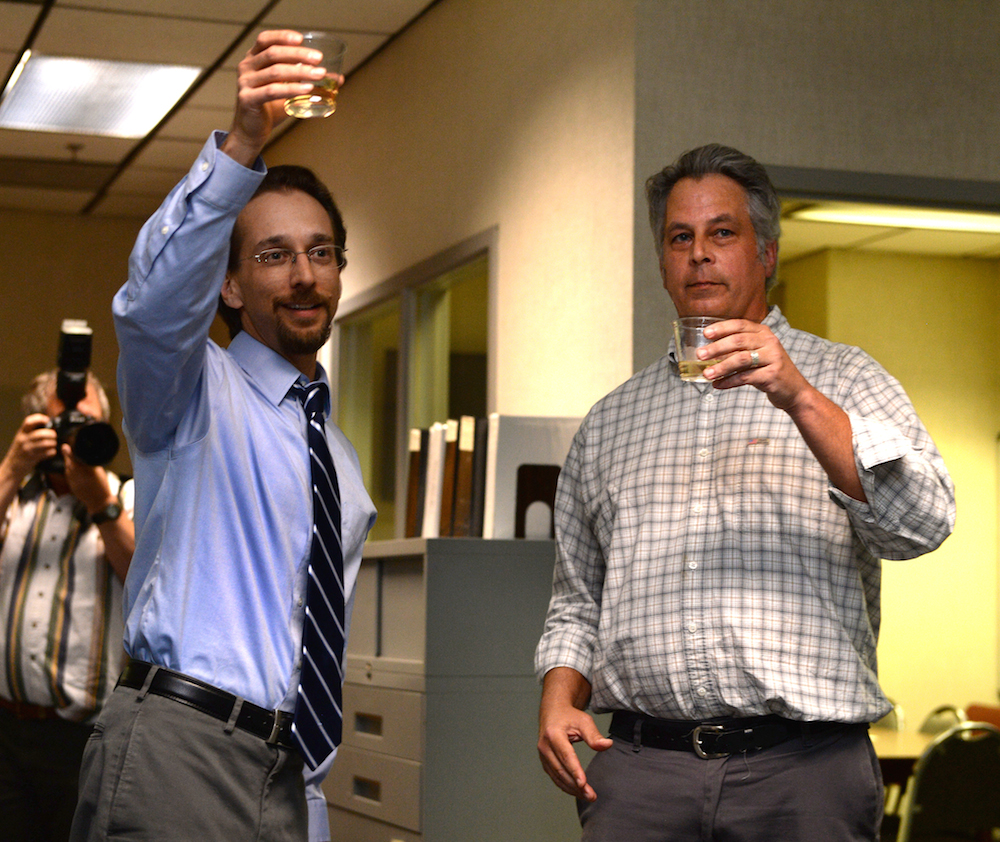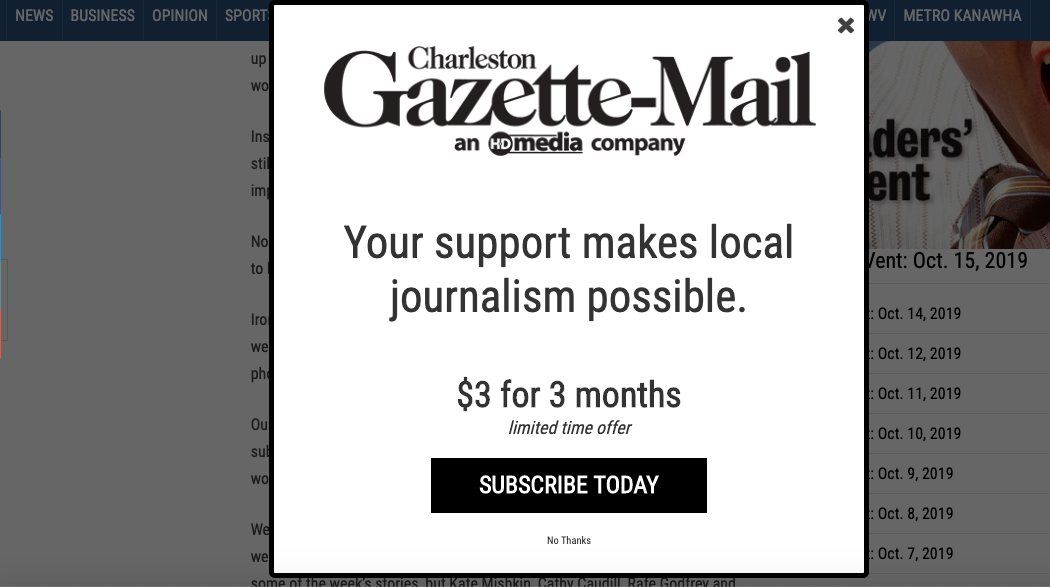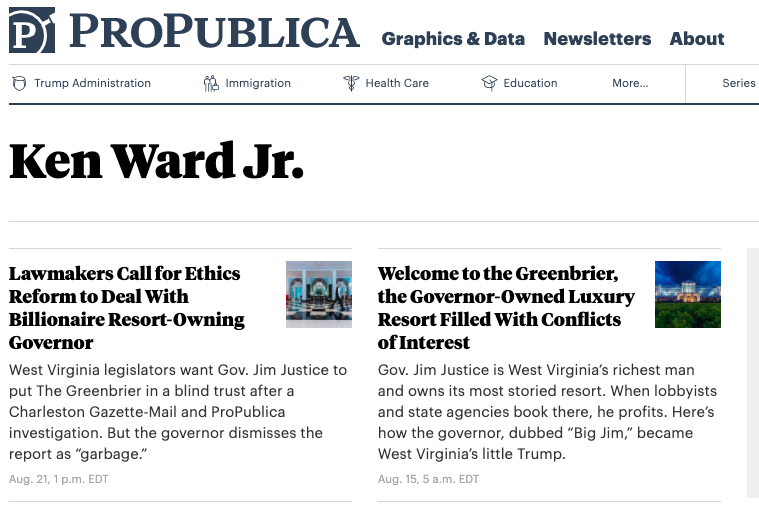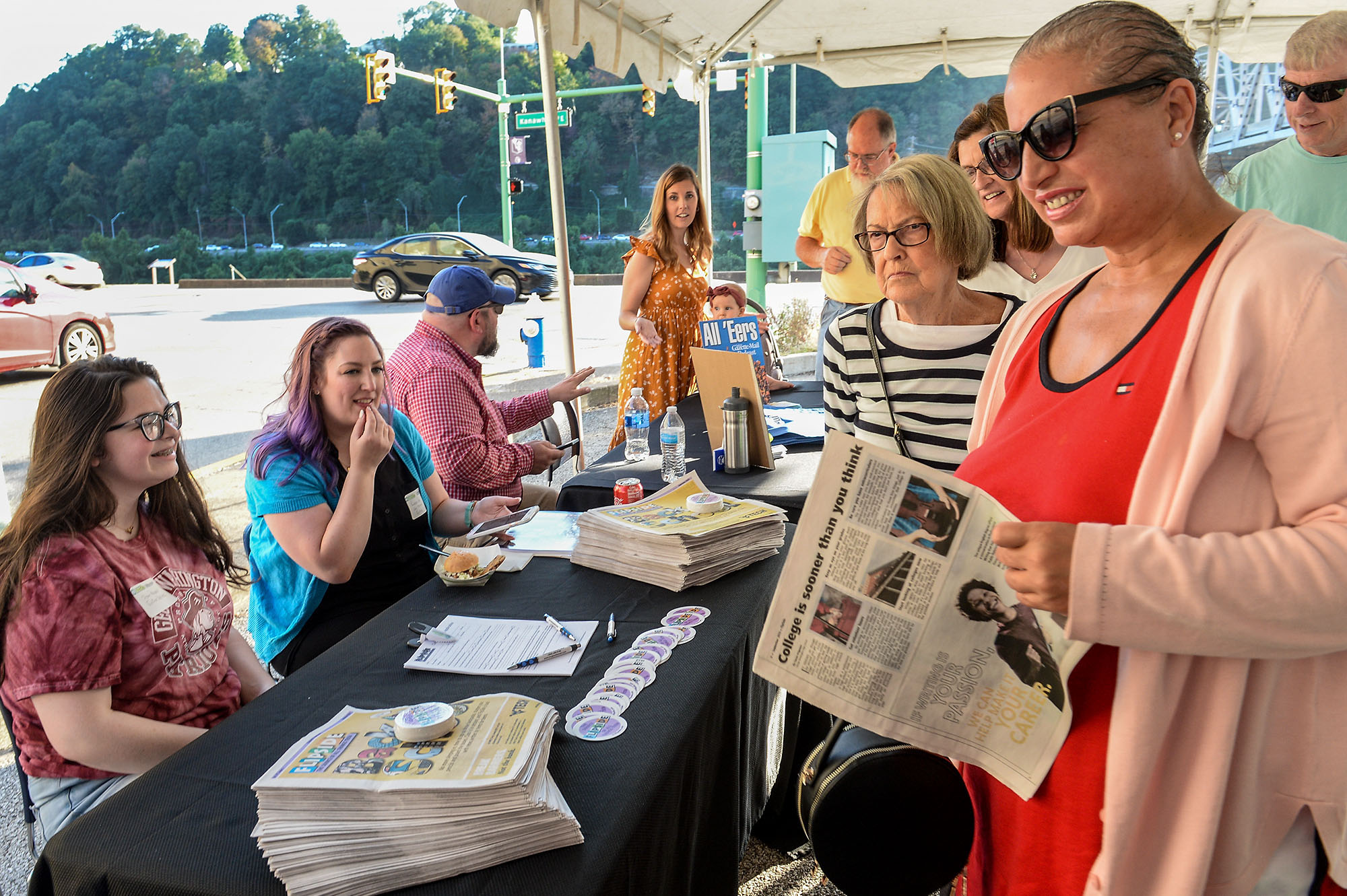In the fall of 2018, the new publisher of the Charleston Gazette-Mail sat some of his staff down at a conference room table.
He had a goal: He wanted digital subscriptions doubled in a year.
“And we all looked at each other like, how are we going to do that?” said Greg Moore, who’d been executive editor for just six months.
That year, the paper declared bankruptcy, went up for auction, got new local owners and went through layoffs.
Staff didn’t even know where to begin.
But this September, Moore wrote a column with some news: Despite a rough 2018, in September, the Gazette-Mail managed to more than double digital subscriptions. And they did it with three months to spare.
The victory might be small – those 4,341 digital subscriptions currently make up 8.5% of circulation revenue.
But the changes that got the Gazette-Mail there were also fairly simple – a tightened paywall, aggressive subscription offers, collaboration across departments, national partnerships and a newsroom that’s starting to embrace its role in saving itself.
“There are some days, you look at the future of newspapers and there’s not a lot of good news,” Moore said. “And this is some good news.”

Sustaining the outrage
By the time Ken Ward Jr. came to The Charleston Gazette as a summer intern in 1989, publisher Ned Chilton had already died. But Chilton’s mantra – that the newspaper should practice “sustained outrage” – remained.
“That spirit and that idea of what journalism was was what made me want to come here as a young reporter right out of college,” said Ward, a 2018 MacArthur fellow.
It’s the kind of work Ward and his colleagues pursued. But over time they watched the business of the newspaper get worse and worse as the newsroom itself went through a rollercoaster ride of change.
In 2015, the Gazette merged with the Charleston Daily Mail. In 2017, the combined paper won its first Pulitzer for Eric Eyre’s investigation into the opioid crisis. (The Charleston Daily Mail won a Pulitzer in 1975 for editorial writing.) In January of 2018, the paper declared bankruptcy.
At the time, newsroom staff was told that the likely buyer was Ogden Newspapers, which owns more than 40 dailies in the United States and is based in Wheeling, West Virginia.
A group of long-time readers in Charleston filed a petition with the judge during the bankruptcy proceedings that stressed the importance of local ownership. In April of 2018, a group of local investors joined with the owner of the newspaper in Huntington, West Virginia, and made a successful bid for the paper.
Rob Byers, then the executive editor, was among those laid off in the ownership transition, which was a big blow for the newsroom, Ward said.
“He had been an editor who led us to a Pulitzer Prize – our first.” (Byers declined to comment for this article.)
Moore, who started at the Gazette 23 years ago, was named executive editor. While recovering from losing a long-time colleague in Byers, Moore and others started working to refocus a smaller newsroom on picking its shots.
Related: Did we just experience the hardest decade in journalism?

What’s worked
For local newspapers, the switch to digital has been more slog than swift, but we’re starting to see some signs of success. In Whiteville, North Carolina, The News Reporter increased digital subscription revenue by 493%, replacing revenue lost from subscribers “almost to the dollar,” publisher Les High told Poynter in September. In Charleston, South Carolina, The Post and Courier grew digital subscriptions by 250%.
Staff in both of those newsrooms started using data to make better choices about what to cover. Both also have local owners. Those things are true, too, in Charleston.
The Gazette-Mail is located in and covers the capital of West Virginia, where just over 47,000 people live.
Here’s what’s worked for the Gazette-Mail so far:
They expect to be paid for their work: One of the easier things staff at the Gazette-Mail did was tighten up its paywall. It was full of holes and could be breached by going through social media.
It was also more of a payhedge.
At one point a few years ago, readers got 10 free stories a month.
Now, they get two.
“People have been reading our stuff for free online for awhile, and we work hard to put this stuff out there,” Moore said. “We think this is a good number. We think it’s a taste.”
The offers to get people to pay up are also pretty aggressive.
Initial offers start at 99 cents a month, and go as high as $13.95. So far, most new subscribers are paying between $.99 and $7.99 a month, said Jim Heady, the publisher. Early on, he worried that after the initial offer ended and the price rose, people would cancel, but “that wasn’t the case, which was really surprising to me,” he said.
Between the $7.99 and $13.95 monthly rates, the Gazette-Mail has an 85% retention rate.
They’re working together across the newspaper: The Gazette-Mail now has weekly digital strategy meetings that include people from circulation, marketing and editorial. One example – they’ve looked at analytics on stories that drive subscriptions. Those stories are the same watchdog work the Gazette-Mail is known for.
That gives journalists an incentive to say no to stories that don’t live up to those standards, said environmental reporter Kate Mishkin.
“I’m not gonna waste my time with a stupid story. We’re gonna do good work, and we’re gonna find things that are wrong, and we’re gonna expose them, and we’re gonna fix it.”
They’re telling their own story better: Ward sees another big shift – many of the Gazette-Mail’s journalists are starting to get better at making the case for why their work is worth subscribing to, both in in-person interactions and on social media.
“I frankly think that one of the main things that the newsroom has done is started promoting ourselves and promoting the idea that we’re members of the community and we’re providing something we think that the community needs, and if you agree, how about supporting us?”
They’ve benefitted from some reinvestment: A lot of critical open reporting jobs have gone unfilled, Ward said, but the paper’s new owners did invest in podcast equipment and training for a weekly podcast.
Mishkin and others launched the Mountain State Morning podcast in July of last year. Nearly a year later, when she was accepted for training with Transom, a project through the non-profit Atlantic Public Media, the owners were quick to approve the expense, she said.
And recently, that podcast got a sponsor.
“It shows when you invest in something, when an owner is willing to take a chance and put some money down, it comes out so much better,” Mishkin said.
They have national partners: The Gazette-Mail and Ward have worked with ProPublica’s Local Reporting Network for two years. That project funds the position of a local investigative reporter and offers editorial support. The paper currently also has two reporters from Report for America, which places reporters into local newsrooms and co-funds them for one- and two-year assignments.
Both partnerships, Ward said, brought new energy into the newsroom and offered a model for how to be a mission-driven organization. At ProPublica, Ward said, everyone seems excited about what they’re working on. That’s something newspaper reporters need.
“For the love of God, if you’re bored by the story you’re writing, what makes you think anybody would be interested in reading it?”
Related training: Will work for impact – The fundamentals of investigative journalism

Less is actually less
Local newspapers are significantly smaller than they once were.
These numbers might be familiar by now, but they’re helpful in understanding industry-rocking changes and the inability to quickly adapt to them: From 2008 to 2018, employment at local newspapers shrunk by 47%, according to Pew Research Center.
About 30 people currently work in the Gazette-Mail newsroom.
Many newspaper staffs now accept the idea that they can’t be all things (they never were, but that’s another story.)
In talking with people in Charleston, this came up a few times:
“I believe very strongly that the only thing you can do with less is less,” Ward said.
“… At some point, you can’t do anything but less with less,” Moore said. “That’s just logic.”
For both men, the Gazette-Mail is a very different place than the one where they first started working at the beginning of their careers. They’ve had to learn to say no to news that they’d once go after, such as a bad crash on the interstate.
Moore reminds himself that local TV will be there and cover it.
“If we want to be the place that gets people to subscribe because we do things no one else does, that’s not where we can point our resources.”
Some readers have objected to the shift, Ward said, but staff has tried to explain what they’re covering and why, both in person and through their work.
“Less is less” is not an excuse to resist experimentation, however.
“I’m sure at some point, someone in this newsroom has maybe said ‘You can’t do less with less,’” Mishkin said. “And it’s true.”
But it doesn’t mean you can’t figure new things out, like she and Catherine Caudill, an assistant news editor and a copy editor, did in teaching themselves how to build a podcast, which now has a sponsor and is bringing in a profit.

Still kicking
The next digital subscription goal for the Gazette-Mail is to reach 5,000 by the end of the year, said Heady, the publisher. By the end of 2020, he’d like to double that, making digital subscriptions close to 20% of circulation revenue.
“And I think by the way they’re going, that very well could happen.”
The Gazette-Mail has its financial struggles, like anyplace else, he said. Overall performance is good. It could be better.
But they reached a goal, and they did it by working together, he said.
“It’s like, wow, why didn’t we do this 20 years ago?”
Like any newsroom, not everyone is a convert to the changes at the Gazette-Mail, Ward said.
He understands why.
His colleagues look around and see empty chairs, missing coworkers and uncovered beats. Things are not like they used to be.
But readers don’t care about any of that, Ward said.
“Unless we are showing our readers some strength and some guts and some gumption, they’re just going to stop reading and see what’s on Facebook today.”
It’s time for local journalists to get off the mat and back in the game, he said, “show our readers that we’re alive and we’re still here and we’re still kicking.”
Kristen Hare covers the transformation of local news for Poynter.org. She can be reached at khare@poynter.org or on Twitter at @kristenhare
Correction: In a caption, Eric Eyre and Rob Byers were misidentified as each other. We apologize for the error. It has been corrected.
Update: The story has been updated to include mention of the Charleston Daily Mail’s 1975 Pulitzer Prize.







